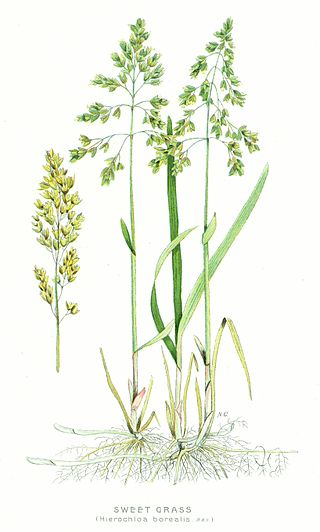 Hierochloe odorata or Anthoxanthum nitens (commonly known as sweet grass, manna grass, Mary’s grass or vanilla grass, and as holy grass in the UK, is an aromatic herb native to northern Eurasia and North America. It is a sacred grass of the indigenous peoples of Canada and the United States. It is used as a smudge, in herbal medicine and in the production of distilled beverages. It owes its distinctive sweet scent to the presence of coumarin.
Hierochloe odorata or Anthoxanthum nitens (commonly known as sweet grass, manna grass, Mary’s grass or vanilla grass, and as holy grass in the UK, is an aromatic herb native to northern Eurasia and North America. It is a sacred grass of the indigenous peoples of Canada and the United States. It is used as a smudge, in herbal medicine and in the production of distilled beverages. It owes its distinctive sweet scent to the presence of coumarin.
Hierochloe odorata is a very hardy perennial, able to grow to the Arctic Circle. Its leaves do not have rigid stems, so only grow to about 20 cm (7.9 in) in height, and then the leaves grow outward horizontally to 100 cm (39 in) long or more, by late summer. The base of the leaf, just below the soil surface, is broad and white, without hairs; the underside of the leaf is shiny and glabrous. In the wild, the bases of the leaves are frequently purple-red colored, and this indicates a phosphorus-deficient soil.
Holy grass was strewn before church doors on saints’ days in northern Europe, presumably because of the sweet smell that arose when it was trodden on. It was used in France to flavor candy, tobacco, soft drinks, and perfumes. In Europe, the species Hierochloe alpina is frequently substituted or used interchangeably. In Russia, it was used to flavor tea. It is still used in flavored vodka, the most notable example being Polish Żubrówka. Native American traditions Making Sweet Grass Medicine, painting by Joseph Henry Sharp Sweet grass is widely used by North American indigenous peoples from many different Nations. Among many of the Plains Indians it is considered one of the “four sacred medicines”. Though being used for many purposes, its main purpose for many tribes is to attract good spirits. It is also known as the “Hair of Mother Earth”.


 Deutsch
Deutsch